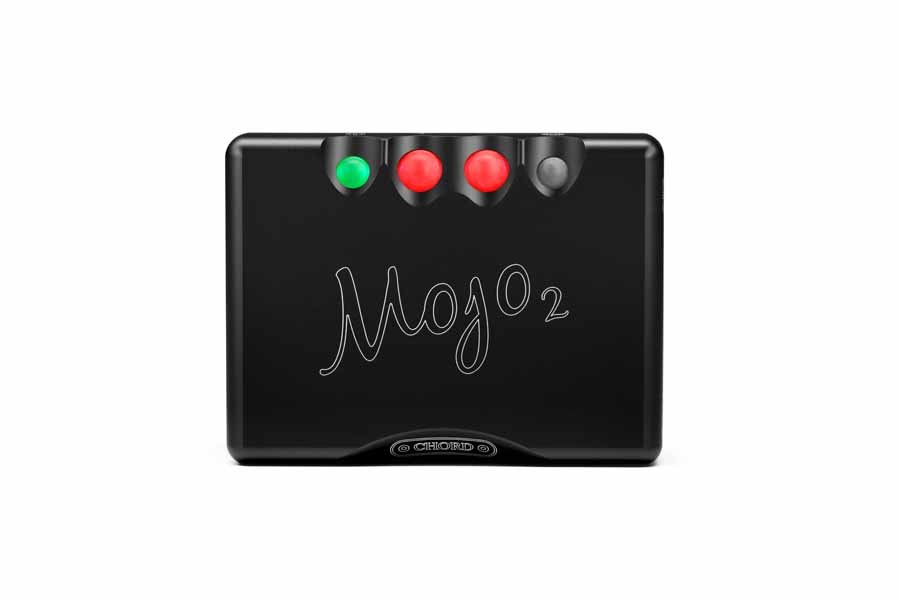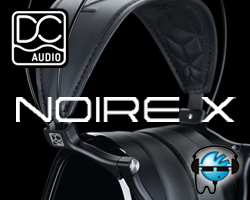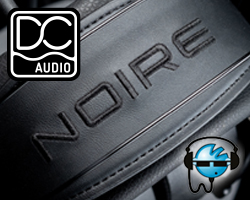CHORD ELECTRONICS MOJO 2 DAC AND HEADPHONE AMP REVIEW
MoJo2 is the latest iteration of Chord Electronics Mojo portable headphone amp and DAC. This version has internal improvements that include onboard DSP to tailor the sound. Stuart Smith has a listen.

The new Chord Electronics Chord Mojo 2
I really liked the original Mojo from Chord Electronics and thought it offered an excellent option for those looking for a DAC that was useable at home in a small main system, desktop system, or portable system. Of course, Chord Electronics Poly was designed to be partnered with the original Mojo and whilst I never gelled with the Poly on the go, I thought it was an excellent, highly compact option for bringing streaming into a system where space was at a premium – and for those who gel with it a no-brainer option for picking up and taking out with them too. Now, me not gelling with a product doesn’t mean that it doesn’t have its merits and when Chris Baillie reviewed the pairing for HiFi Pig he loved it for use whilst out and about, awarding it a five-heart gong. I suppose this is a case of personal preferences getting in the way and me being not much of a listener of music whilst out and about. However, from a look and feel perspective I still think Mojo/Poly pairing is one of the nicest designed portable products I’ve yet to experience – it just feels “right” in your hand – and I’m well aware of me being in a minority of one given the praise from press and public alike lauded on the chord MoJoPoly.
ENTER THE NEW CHORD MOJO 2
In the box, there’s the Mojo itself, a USB to Micro USB cable, basic instructions, a scannable QR code to download the full instructions and a set of obligatory safety instructions.
On the face of it the new Mojo looks near as damn-it identical to the old Mojo, but look a little closer and there are clear differences. The illuminated control buttons (spheres) are smaller and there’s four of them is the most obvious difference, but there is also a USB C socket around the side, though the latter can be used only for data and not charging. It connects to Poly in exactly the same way as the previous Mojo.
As well as the USB C input there’s a coaxial input, a micro USB input for data and optical input and then finally a micro USB charging port. Now I think this is where Mojo comes into its own with regards to flexibility and having that optical and coaxial port make it useful for use in a home system whether or not you have the matching Poly. Connection to Poly is, as mentioned the same as for the original Mojo, and I guess that’s why it’s still got the micro USB there for charging rather than using the USB C.
The inputs, apart from the micro USB with USB C can all be connected at once should you so wish but Mojo will automatically select the input when you start to play music. It will do this with USB taking priority over coaxial and coaxial taking priority over optical.
Like the original Mojo, you have a couple of headphone outputs meaning you can have a couple of people sharing the music playing. To connect to a main system you are going to need a mini-jack to stereo RCA pair cable.
Press the on button and Mojo will do its momentary start-up and then make an audible click to let you know it’s ready to use.
The new fourth button on the MoJo is the menu button which will allow you to scroll through different options and alter their parameters. This is where perhaps the most obvious difference between Mojo and MoJo2 is to be found – MoJo 2 has UHD DSP control allowing the user to tailor the output of the device to personal preferences and to the type of files playing. Essentially what you have is a set of advanced tone controls. Now I know that tone controls went out with the Ark with regards to high-end audio, but I personally never really understood why this was as I always thought well-implemented tone controls offered an amp a greater degree of flexibility with regards to the recording, the room and the listeners personal preferences/hearing. This feature is also useful for getting the best out of your headphones, each of which will have a different response curve – basically, you can achieve a flatter response from your cans.
Anyway, the controls available are accessed through clicking and cycling through the options (whereupon the button changes colour to indicate the parameter you are in) with the options being: Bass 20Hz, Bass 125Hz shelf, Treble 3kHz Shelf, Treble 20kHz. So essentially what you have is the ability to change lower bass, mid-bass, lower treble and upper treble. Each of these parameters can be increased or decreased (nine steps either way) using the two larger buttons until you find the sound that suits you best. The larger buttons change colour to let you know at what level you are. This whole colour thing does take a little getting used to, but to be fair, most people will just get it to the level that sounds right to them and adjust accordingly by ear. Usefully, and not really surprisingly, MoJo will save these settings when you turn the unit off and back on again.
There is another menu option that you access by pressing the menu button once until it turns blue. This is the Crossfeed parameter and is designed to alter and improve the spatial effects that you get through your cans and it has four positions which are again indicated by the changes in colour and are cycled through using the volume + button.

Spot the new USB C input for data
The final menu option engages Lockdown Mode which disables all the controls and is for when you are travelling, presumably to stop Mojo turning on inadvertently. Now, I can’t decide if using the term Lockdown Mode is marketing genius given the last couple of years we’ve spent on lockdown mode, or if it’s a bit of an odd phrase to use – the jury is out on that one.
Getting Mojo back to its flat state where none of the DSP options are activated and all are reset to zero is a simple case of holding down the volume up and down buttons together.
The power button on the Mojo 2 changes its colour dependent on the sample rate that the file playing is rendered in and MoJo will play files up to 32bit/768kHz and DSD 256 which will satisfy pretty much everyone. DSD on a portable device may seem like overkill given they are very large files but Poly (if that’s what you are using) will accept any capacity of SD card up to 2TB and so in theory you could carry your whole collection of digital music in your pocket, whatever the file format.
So that’s about it with regards to the features of the Mojo 2. It’s beautifully finished, feels perfect in your hand and has the right kind of weight to it to feel substantial but not too heavy.
Technically, inside the MoJo2 improvements have been made and include improved battery management and charging, improved WTA filter, an improved 4e Array DAC for lower distortion and lower out of band noise, and a claimed more neutral balance through the elimination of coupling capacitors. I was sent a presentation by Rob Watts who is the technical mastermind behind MoJo and many other of Chord Electronics technical innovations, but to be honest most of it went over my head and is far too technical for the purposes of this review. Like any product we review at HiFi Pig, the main things we look at are build and features and then how it sounds. How this all happens is not much more than of passing interest – YMMV.
In summary then, the MoJo2 looks and feels like a quality item and it has plenty of features that, rather than appearing to be stuff dreamt up by a marketing department, actually have a sound sonic purpose. Getting to know the functions without some kind of screen and having to rely on colour changes in the buttons is a departure from other brands’ offerings and they do take a little while to get used to without having to constantly refer to the user manual, though you do get used to them pretty quickly.

The colourful, illuminated, spherical buttons on the Mojo 2 now number four
SOUND QUALITY
Using the Pixel 3XL smartphone running Roon via the USBC cable was a pretty straightforward set up with my only issue being having to switch off fixed volume in Roon settings to use the device volume. Once set this is good to go. The connection to the computer was simple, and using the Optical in I also connected our CD player and played the Mojo2 through one of our main systems.
Sonically using the Audeze Sine in-ears there’s a similar sound quality apparent using the flat settings on the MoJo as from the Mojo one – dynamic and powerful sound with silent backgrounds. That’s not really much of a surprise and what I really wanted to get into was the usefulness of the onboard DPS settings of this version 2, after all, and on the face of it, that’s what most folk are going to take away as being its defining features over and above the original Mojo.
The routine to get into these parameters is to press the menu button a couple of times until it turns red (low-bass) and then cycle through for the other functions; yellow (mid-bass), green (low-treble), blue (upper-treble).
Now purists may scoff at these controls, but, as I’ve mentioned earlier, I reckon good quality tone controls are a useful feature to have. With regards to the DSP controls on Mojo2 I found the mid-bass and low-treble functions to be pretty useful and very effective in tailoring the sound to the headphones I was using or to “enhance” either bright or lifeless tracks. In short, they work as advertised. The upper-treble and lower-bass controls work perfectly well, but I found them less useful and much more a case of “fine-tuning” the sound, whereas the other two controls were much more obvious in their effect.
The DSP effect that really caught my attention when reading the marketing bumph about MoJo2 was the “Crossfeed” feature. In truth, I’d expected this feature to be way over the top and I was looking forward to telling you that it was a bit of an overblown gimmick. The truth is that it’s actually pretty subtle and certainly not a case of trying to crack a nut with a lump hammer. It does have the effect of slightly opening up the sound and presence of the music you are listening to, but not to the extent (even on its strongest of three options) to make the effect sound artificial or overblown – this could have very easily been the case.
Using a variety of headphones and whatever the source of the files (and indeed type of files) I thought the Mojo2 had great control and went way loud enough. Sonically it is even and sure-footed with the DSP turned off and with enhancements being apparent to a greater or lesser degree when turned on.
In the main system fed by a Leema Elements CD player into the optical input on the MoJo and output through a mini-jack to into the LAB12 preamplifier, I thought the sound was very good for a DAC at this kind of price and aimed primarily at mobile users. The same clean and clear characteristics were apparent and that sure-footedness was still there, as was the very low noise floor. Sonically it’s not on a par with the LAB12 DAC it replaced in this system, but in truth what did you expect given the massive price differences? Personally, I could see Mojo2 being used in conjunction with Poly or a Raspberry Pi and a pair of powered speakers in a bedroom or office system and in this regard I reckon it would make a great sounding option that could also be picked up and taken out – fabulously compact and great value to boot.

Chord Mojo 2 and Chord Poly
CONCLUSION
This is a very good sounding headphone amp and portable DAC, as was the original Mojo. Where the new unit wins out is its onboard DSP that really does work and really does come in useful when wanting to improve the sonics of a less than spectacular set of headphones and boosting crappy recordings to be more appealing. I also thought the upper-treble feature was useful in reducing the apparent “digitalness” of some hi-res recordings – YMMV.
Seeing this as not just a unit to use out and about but also in the home makes the price seem very attractive indeed. Even as a mobile-only head/DAC it offers good value with regards to the impressive build quality, features and sonic abilities.
I suppose the question that many will ask is “Why buy this when I’ve already got an original of the Mojo?” And that is a very valid question. However, this is a different beast, though not wholly different. If you are in the market and don’t own a Mojo, then the decision is a simple one. If you own an original Mojo then the internal discussion will become more difficult. For me, I’d say that you will still get a very good price for the original and excellent Mojo on the used market, making the upgrade to Mojo2 and its slightly better performance and excellent DSP not quite the outlay it would first seem.
AT A GLANCE
Build Quality:
Cool looking
Good number of connection options – the USB C port is an excellent addition, though it would have been useful to be able to charge via this port too. The reason given for not having this option is that Chord didn’t want to introduce external noise into the circuit
Feels right
Logical controls once you get your head around the colour coding
Good battery life
Sound Quality:
Silent backgrounds
Dynamic and even sound in “flat” mode
DSP controls are not over the top obvious and can be used to subtly enhance either poor recordings/headphones or simply to shape a sound to the user’s preference
Value For Money:
Mojo2 all adds up to a reasonably priced product whose value is increased when looked at as an inexpensive home DAC that can be used out and about too
We Loved:
The ease of use
Quality sonic characteristics
Subtle enhancements using DSP
Good connectivity to mobile and home audio devices
We Didn’t Love So Much:
The coloured lights that tell you what is happening take some getting used to
Gets warm but not hot
Price: £449
Elevator Pitch Review: MoJo2 from Chord Electronics is a £450 headphone amp and DAC with onboard DSP that delivers a solid performance through a wide range of in-ear and conventional headphones. The sonic characteristic is flat, quiet and detailed, though you can tailor the sound to your own likings or to improve the performance of less than flat headphones.

Stuart Smith
- Five digital inputs: coaxial, dual-data coax, optical, Micro-USB and USB-C
- Dynamic range 125.7 dB A wt.
- Noise 2.7 uV A wt., no measurable noise floor modulation
- Distortion and noise 0.00027 % at 2.5 V 300 ohms
- Power output 1 % distortion:
- 90 mW 300 ohms (5.2 V RMS)
- 600 mW 30 ohms (4.2 V RMS)
- 0.06 ohms output impedance
- 118 dB stereo separation 1 kHz 300 ohms 2.5 V
















































































































































































